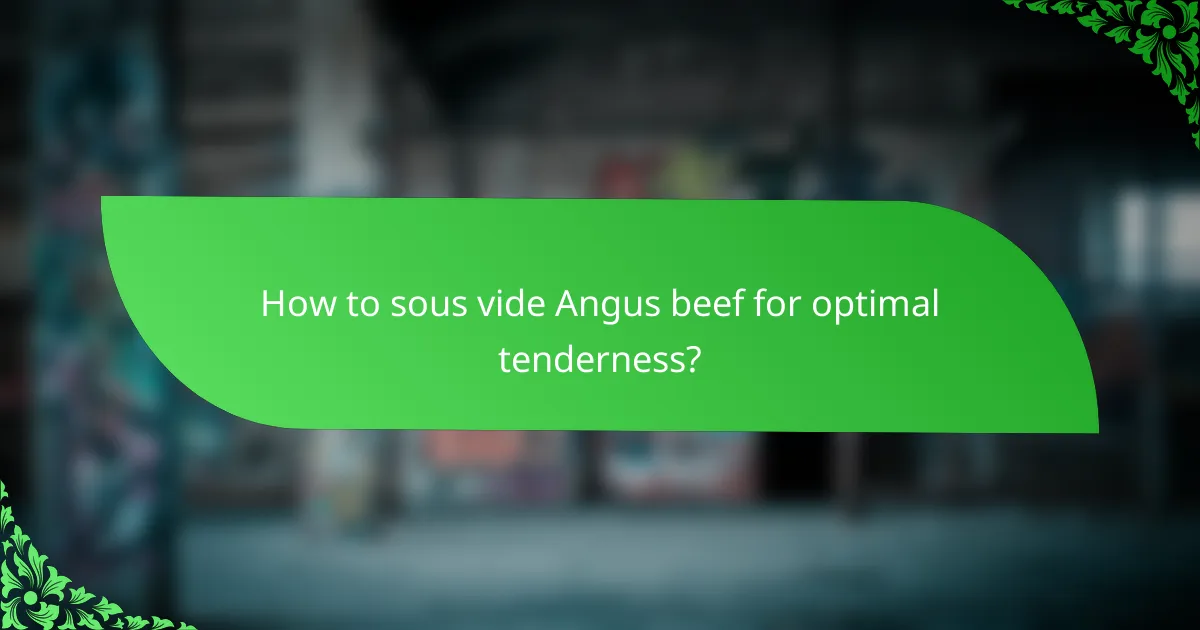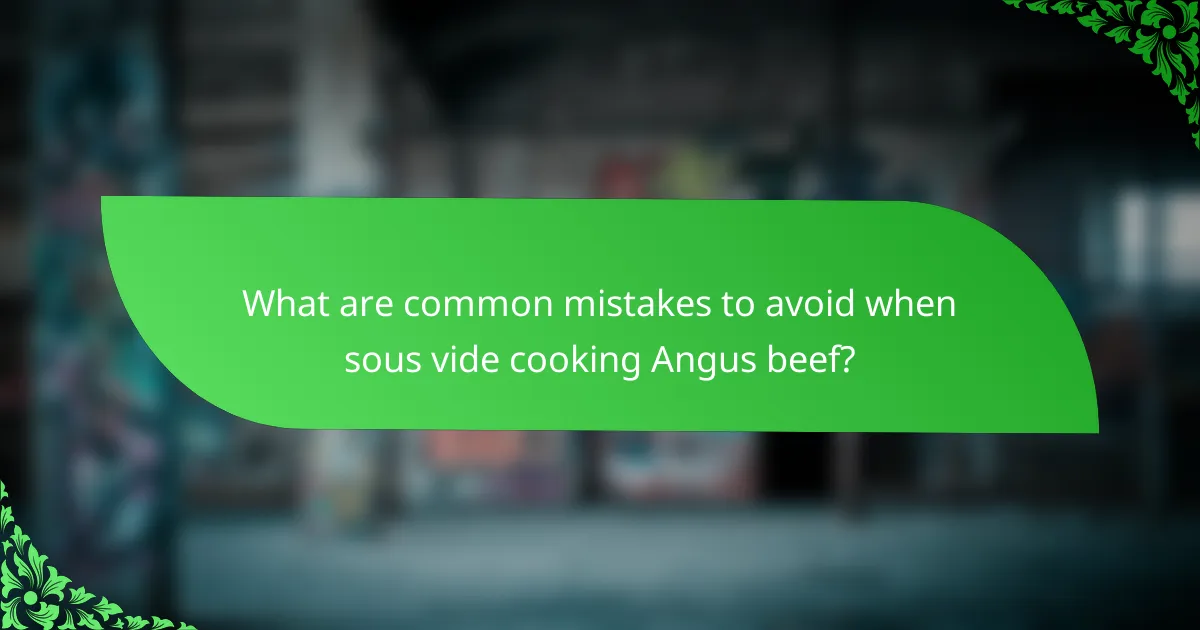Sous vide cooking is an exceptional method for preparing Angus beef, ensuring optimal tenderness and flavor through precise temperature control. By maintaining a consistent low temperature over an extended period, this technique allows the meat to break down connective tissues, resulting in juicy and flavorful dishes. Ideal cuts for sous vide include ribeye steak, filet mignon, and brisket, each offering unique textures that are enhanced by this cooking method.

How to sous vide Angus beef for optimal tenderness?
To achieve optimal tenderness when sous vide cooking Angus beef, maintain a consistent low temperature for an extended period. This method allows the meat to break down connective tissues without overcooking, resulting in a juicy and flavorful dish.
Temperature settings for sous vide Angus beef
The ideal temperature for sous vide Angus beef typically ranges from 54°C to 60°C (130°F to 140°F), depending on your desired level of doneness. For medium-rare, aim for around 56°C (132°F), while medium is best at 60°C (140°F).
Using a precision immersion circulator ensures that the water bath maintains a steady temperature throughout the cooking process. This consistency is crucial for achieving the perfect texture and flavor in your beef.
Recommended cooking times for different cuts
Cooking times for sous vide Angus beef vary by cut and thickness. Generally, tougher cuts like chuck or brisket benefit from longer cooking times, ranging from 24 to 48 hours, while tender cuts such as filet mignon or ribeye can be cooked in 1 to 4 hours.
For example, a 2-inch thick ribeye steak should be cooked for about 2 hours at 56°C (132°F) for medium-rare. Always consider the thickness of the meat when determining cooking time, as thicker cuts require longer durations to achieve the desired tenderness.
Best practices for seasoning Angus beef
When seasoning Angus beef for sous vide, keep it simple to enhance the natural flavors. A blend of salt, pepper, and optional herbs like rosemary or thyme works well. Apply the seasoning just before sealing the meat in a vacuum bag.
Avoid using too much salt, as it can draw moisture out of the beef. Instead, consider adding a pat of butter or a splash of olive oil to the bag for added richness and flavor during the cooking process.

What are the benefits of sous vide cooking for Angus beef?
Sous vide cooking offers several advantages for preparing Angus beef, including enhanced flavor, consistent doneness, and improved moisture retention. This method allows for precise temperature control, resulting in a superior culinary experience.
Enhanced flavor retention
Sous vide cooking enhances the flavor retention of Angus beef by sealing it in a vacuum bag, which prevents the loss of juices and natural flavors during the cooking process. The low and slow cooking method allows the beef to absorb its own juices, resulting in a richer taste.
To maximize flavor, consider seasoning the beef with herbs and spices before vacuum sealing. This allows the flavors to infuse into the meat as it cooks, creating a more robust profile that traditional cooking methods may not achieve.
Consistent doneness throughout
One of the key benefits of sous vide cooking is the ability to achieve consistent doneness in Angus beef. By cooking the meat at a precise temperature for an extended period, you eliminate the risk of overcooking or undercooking.
For example, cooking Angus beef at 130°F (54°C) for several hours will result in a perfectly medium-rare steak from edge to edge. This level of control is particularly beneficial for thicker cuts, which can be challenging to cook evenly using conventional methods.
Improved moisture retention
Sous vide cooking significantly improves moisture retention in Angus beef, ensuring that the meat remains juicy and tender. The vacuum-sealed environment prevents moisture loss, which is a common issue with traditional cooking methods that expose meat to air.
To further enhance moisture retention, avoid opening the sous vide bag until you are ready to serve. This helps maintain the internal environment and keeps the beef succulent. Additionally, consider finishing the beef with a quick sear on high heat to develop a flavorful crust without compromising its moisture content.

Which Angus beef cuts are best for sous vide?
The best Angus beef cuts for sous vide cooking include ribeye steak, filet mignon, and brisket. Each cut offers unique flavors and textures that benefit from the precise temperature control and long cooking times that sous vide provides.
Ribeye steak
Ribeye steak is renowned for its marbling, which contributes to its rich flavor and tenderness. When cooked sous vide, ribeye can achieve a perfect medium-rare texture while retaining its juiciness. A common temperature range for ribeye is between 54°C to 60°C (130°F to 140°F), cooked for 1 to 4 hours.
To enhance the flavor, consider seasoning the ribeye with salt and pepper before sealing it in a vacuum bag. After sous vide cooking, a quick sear on a hot grill or skillet can create a delicious crust.
Filet mignon
Filet mignon is one of the most tender cuts of beef, making it ideal for sous vide preparation. This cut is best cooked at a slightly lower temperature, typically around 52°C to 56°C (125°F to 132°F), for 1 to 3 hours. This method ensures that the filet remains buttery soft and flavorful.
For added richness, consider marinating the filet mignon or adding a pat of herb butter before sealing. A quick sear after cooking will enhance its appearance and flavor, giving it a restaurant-quality finish.
Brisket
Brisket is a tougher cut that benefits greatly from the low and slow cooking method of sous vide. Cooking brisket at temperatures between 56°C to 68°C (132°F to 155°F) for 24 to 48 hours allows the connective tissues to break down, resulting in a tender and flavorful dish.
Before sous vide cooking, rub the brisket with spices or a marinade to infuse flavor. After the sous vide process, a long sear or smoke can add depth to the brisket, making it a standout dish for any barbecue or gathering.

What equipment do I need for sous vide Angus beef?
To sous vide Angus beef effectively, you need an immersion circulator, a vacuum sealer, and food-safe bags. These tools ensure precise temperature control and proper sealing for optimal cooking results.
Recommended sous vide immersion circulators
When selecting a sous vide immersion circulator, look for models with a temperature range of at least 0-100°C and a good wattage (around 800-1500 watts) for efficient heating. Popular brands include Anova, Joule, and Sansaire, which are known for their reliability and user-friendly interfaces.
Consider features like Wi-Fi connectivity or Bluetooth capabilities for remote monitoring. A circulator with a clamp or a sturdy base will help secure it to various pot sizes, ensuring stability during cooking.
Best vacuum sealers for meat
A quality vacuum sealer is crucial for sous vide cooking, as it removes air from the bags, preventing floating and ensuring even cooking. Look for sealers that offer both automatic and manual sealing options, with a strong suction power to handle thicker meats like Angus beef.
Brands like FoodSaver and Nesco provide reliable options, often with built-in bag cutters and roll storage. For home use, a countertop model is typically sufficient, while commercial-grade sealers are available for those who cook in larger quantities.

How to finish sous vide Angus beef for a perfect crust?
To achieve a perfect crust on sous vide Angus beef, you need to apply high heat quickly after the sous vide process. This can be done through searing or grilling, both of which enhance flavor and texture while ensuring the interior remains tender and juicy.
Searing techniques using cast iron skillet
Using a cast iron skillet is one of the most effective ways to finish sous vide Angus beef. Preheat the skillet over medium-high heat until it is smoking hot, then add a small amount of oil with a high smoke point, such as canola or grapeseed oil.
Once the oil shimmers, carefully place the sous vide beef in the skillet. Sear each side for about 1-2 minutes, or until a rich brown crust forms. Avoid overcrowding the skillet, as this can lower the temperature and prevent proper searing.
For added flavor, consider adding butter, garlic, or fresh herbs to the skillet during the last minute of searing. Baste the beef with the melted butter for an enhanced taste.
Grilling methods for finishing
Grilling is another excellent method to finish sous vide Angus beef, imparting a smoky flavor that complements the meat’s richness. Preheat your grill to high heat, ensuring the grates are clean and well-oiled to prevent sticking.
Place the sous vide beef on the grill for about 1-3 minutes per side, depending on the thickness of the cut. Keep the lid closed to maintain high temperatures, which will help achieve a good sear while keeping the interior moist.
For optimal results, consider using a two-zone grilling setup, where one side is hotter for searing and the other cooler for finishing. This allows you to control the cooking process better and avoid overcooking the meat.

What are common mistakes to avoid when sous vide cooking Angus beef?
Common mistakes when sous vide cooking Angus beef include overcooking the meat, not seasoning properly, and failing to sear after cooking. Avoiding these pitfalls ensures a tender, flavorful result that highlights the quality of Angus beef.
Overcooking the meat
Overcooking is a frequent error in sous vide cooking, as the low and slow method can lead to a mushy texture if left too long. Angus beef should typically be cooked for a range of 1 to 4 hours, depending on the cut and thickness, with thicker cuts benefiting from longer cooking times.
To prevent overcooking, use a reliable sous vide immersion circulator and set the temperature according to your desired doneness. For example, cooking at 130°F (54°C) will yield medium-rare, while 140°F (60°C) will result in medium. Always refer to recommended cooking times for specific cuts.
Additionally, consider using a timer or an app to track cooking duration. If you’re unsure, err on the side of caution and check the meat a bit earlier than planned; you can always return it to the water bath if it needs more time.
